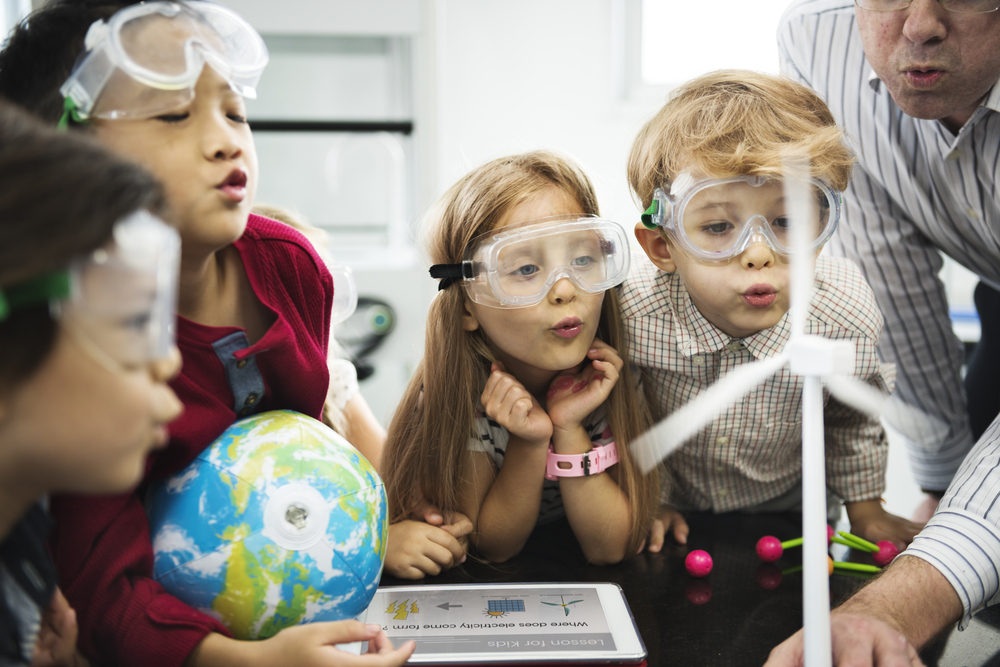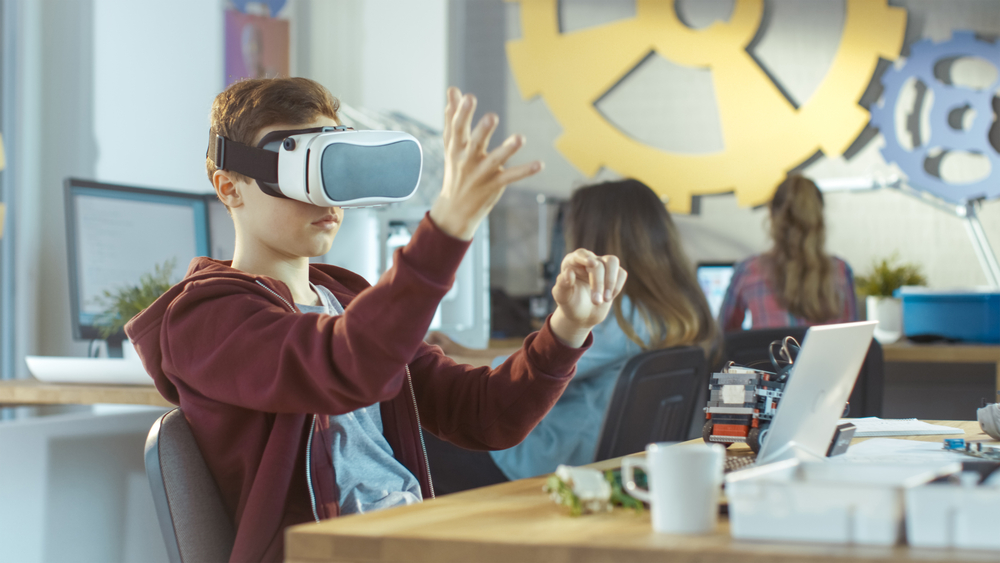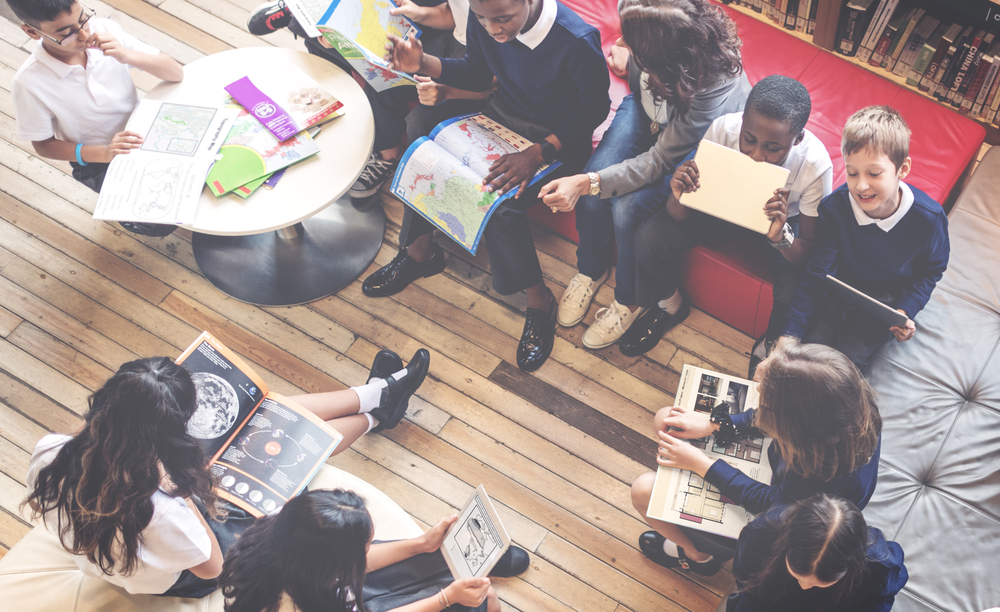Discovery Learning Method
It’s a picture we’ve seen all too often: an elementary school student slumped over at his desk, bored and restless, his face barely supported in his hands. He is trying not to fall asleep as his teacher drills content about basic anatomy: the heart is here, the lungs are here, the kidneys are here…The teacher gives the class a worksheet asking them to fill in which body parts go where. It’s due at the end of the period and the only way to measure whether the students have learned anything is based on this worksheet and the inevitable unit test.
 Now imagine this: elementary students walk into a classroom and see a basic skeleton with a models of the heart, lungs, kidneys, stomach, and intestines laying on a table in the center of the room. Students gather around in a circle, see the model organs, giggle, and begin to guess the name of each body part, its function, and, through trial and error, figure out where each organ fits in the model.
Now imagine this: elementary students walk into a classroom and see a basic skeleton with a models of the heart, lungs, kidneys, stomach, and intestines laying on a table in the center of the room. Students gather around in a circle, see the model organs, giggle, and begin to guess the name of each body part, its function, and, through trial and error, figure out where each organ fits in the model.
Both lessons have been used by teachers, but one lesson has students actively involved, curious, and engaged. The other relies on direct instruction, rote memorization, and knowing information “for the test.” One lesson is memorable for students. The other relies on a student memorizing information. Which lesson will have a lasting impression?

Teaching methods that rely on student-centered learning are considered a more effective style of teaching because, as the name suggests, lessons are based on the student and meeting his or her psychological needs to achieve learning outcomes. If an educator takes a child’s development into consideration, he or she can prepare lessons that will not only engage the student but also leave a lasting impression.
John Dewey famously wrote about student-centered learning in the early part of the 20th century. In his book The Child and The Curriculum, he stressed that children need a chance to explore, experience and connect information in order to truly understand and internalize abstract principles. Dewey also felt that curriculum shouldn’t be made interesting to students, but should instead already be of interest to students in order to avoid apathy.
One of the most used versions of student-centered learning is the Discovery Learning Method.
Background and Characteristics
The Discovery Learning Method is an active, hands-on style of learning, originated by Jerome Bruner in the 1960s. Bruner emphasized that we should be “learning by doing.” With this method, students actively participate instead of passively receiving knowledge. Students interact with their environment by exploring and manipulating objects, wrestling with questions and controversies or performing experiments. They are encouraged to think, ask questions, hypothesize, speculate, cooperate and collaborate with others. They develop confidence in problem solving and feel comfortable using knowledge they already have. Instead of a student being an empty vessel for a teacher to fill with knowledge, the Discovery Learning Method takes into consideration that all students have some background knowledge that they may be able to apply to the current subject at hand.
The Discovery Learning Method is a constructivist theory, meaning it is based on the idea that students construct their own understanding and knowledge of the world through experiencing things and reflecting on those experiences. Willy Wonka very famously said “We are the music makers. We are the dreamers of dreams.” Willy Wonka was a constructivist and his factory constantly used the Discovery Learning Method. That’s what made his Chocolate Factory so exciting to children and adults alike–there was hands-on learning and trying in his factory. Granted, some of the results weren’t favorable, but each time something happened to a child, an Oompa Loompa would sing a song not only reiterating the lesson, but also reminding the children and adults that they should have known something would happen based on their prior knowledge. This hands-on approach created lifelong lessons nobody (not even the people watching it from the comfort of their own homes) would ever forget.
The Discovery Learning Method is also unique in how it presents problems. Teachers will give students a problem and some resources to solve it. This concept alone is very different from standard science experiments you may remember when you were growing up. Most science teachers would give the instructions for an experiment, perform the experiment, show the result of the experiment, and then grade the students on their write-ups of the experiment. There’s not much discovery happening when students see every step and the desired outcome before they even attempt it on their own. Students are simply performing a task they watched someone else do.
The Discovery Learning Method may have a specific end result, but the focus is on the steps and the critical thinking involved in getting there. Teachers have to observe the process, not just grade a written paper at the end of the experience.
Educational Psychologist Jean Piaget viewed children as little philosophers and scientists building their own theories of knowledge. The book Hands-On Science Teaching best summarizes this:
“Piaget’s research clearly mandates that the learning environment should be rich in physical experiences. Involvement, he states, is the key to intellectual development, and for the elementary school child this includes direct physical manipulation of objects.”
Implementing Across The Curriculum
Even though most people associate the Discovery Learning Method with science classes, it can be applied to all parts of a curriculum. In an English class, for example, teachers may introduce the “dreaded” Shakespeare unit with lists of vocabulary for each act and a make students fill out a worksheet while watching a biographical video about Shakespeare and the Globe Theatre. If using the Discovery Learning Method, however, a teacher could give the students a handout to create their own “Shakespearean Insult” by choosing a word from each of three columns. After everyone gets a chance to hurl their best insult (“saucy lily-livered moldwarp” or “peevish evil-eyed crutch” for example), they have a better understanding of Shakespeare’s language and could keep a notebook of insults they come across during the play.
Why Educator Training is Important
The Discovery Learning Method, if used incorrectly, can also be a barrier to learning. If teachers are having activities just for the sake of having activities, then students will not learn concepts. Formal training in this method is necessary for teachers and teachers also have to reflect about how their activity is helping students master a concept. Teachers have to remember that just because something is “hands on” does not mean that it is “minds on”. Canadian educational researchers Scardamalia and Bereiter further explain:
“The shallowest forms engage students in tasks and activities in which ideas have no over presence but are entirely implicit. Students describe the activities they are engaged in (such as planting seeds or measuring shadows) and show little awareness of the underlying principles that these tasks are to convey.”
Successfully Implementing the Discovery Learning Method in the Classroom
 To effectively use the Discovery Learning Method in a classroom, a teacher needs to not only be flexible, but also well-prepared, organized, and have an understanding of how what is discovered in class is educationally valuable and can lead to further investigations for the student. Teachers need to be able to help young children, who are already curious about the world around them, learn how to ask questions that will help them understand their surroundings.
To effectively use the Discovery Learning Method in a classroom, a teacher needs to not only be flexible, but also well-prepared, organized, and have an understanding of how what is discovered in class is educationally valuable and can lead to further investigations for the student. Teachers need to be able to help young children, who are already curious about the world around them, learn how to ask questions that will help them understand their surroundings.
Teachers also have to know where their student is developmentally and how that will play in a role in a child finding success in a lesson. This may sound like a lofty goal, but most educators have to take classes in developmental psychology that are specifically geared to the age with which they want to work. Additionally, teachers using the Discovery Learning Method cannot wait until the end of the activity to access a child. Instead, they interact with students to see what the student is doing, what kind of questions are being asked, and help them apply any new skills that may be necessary to solve problems and draw conclusions. The teacher must also recognize that there is more than one way to get to an end goal.
The Discovery Learning Method is a great choice for ESL students, as well as students with behavioral or developmental problems. The student who can’t sit still in class will have a chance to actively take part in the learning process. The student whose first language is not English will be exploring ideas instead of being told what to think and possibly not understanding the concept because of a language barrier. When the Discovery Learning Method is used,students are on task more often because they are actively part of the learning process instead of just being spectators.
Conclusion
Overall, the Discovery Method is highly supported by educational psychologists. They agree with Kant, Piaget, Vygotsky and Bruner as well as educational philosopher Dewey that learning is based on knowing and doing. If a teacher takes into consideration that a child already has some prior knowledge, then that teacher will be able to show students how their lives are connected to the content without having to work to create that connection.
It takes work to successfully use the Discovery Learning Method in the classroom, and teachers have to be careful to not have class activities just for the sake of having activities. The Discovery Learning Method is hands-on, focuses on the process, and encourages students to look for solutions. Instead of just teaching students to memorize rules or concepts, this method lets them apply ideas to their lives, creating memorable lessons that will help turn them into lifelong learners.
